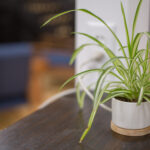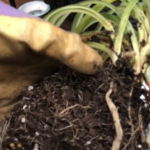Should I Cut Brown Tips Off Spider Plants? Everyone asks these questions. I’m gonna tell you what to do with your spider plant, and it’s not as spiky as you think…
Table of Contents
Should I Cut Brown Tips Off Spider Plants?
Yes, it is advisable to cut your spider plant’s brown tips. Remove the browned tips of leaves with sharp scissors to freshen up your plant and maintain it looking alive and healthy. Simply attempt to make your cut at an angle so that it resembles the natural pointy leaves of the spider plant. This will help you get the desired effect.
Read more: Why Is My Spider Plant Pale And Limp?
Why are the tips of my spider plant becoming brown?
It is essential that you have an understanding of the causes of browning leaves on your spider plant before you begin cutting it.
In addition to the sun exposure, watering, and fertilizer, you should make sure to examine the leaves and, if necessary, the root structure as well.
The following is a list of the most typical factors that lead to browning of leaf surfaces:
Read more: How Do You Bring A Spider Plant Back To Life?
Underwatering or Overwatering
Water is the most prevalent cause of brown leaves on spider plants.
Root rot may be present if the plant is overwatered or if the container contains standing water. There’s not much you can do if it’s taken over the entire root system.
When there is a problem with underwatering, the leaves will wilt and dry out, developing brown tips and edges along the way. Only water your plants when the soil can be felt to be dry and there is no standing water in the drainage basin.
Excessive direct sunlight
Shade and indirect light are ideal conditions for spider plants. Therefore, if it is exposed to an excessive amount of sunlight, the leaves may become scorched and eventually turn brown.
This occurs as a result of water condensing overnight on the tips of the leaves of the plant. Sun scalds are caused by dew acting as a magnifying glass on the leaves when the sun shines on them. Browning can also be caused by a lack of sunshine, so provide the plant with four to six hours of indirect sunlight every day.
Read more: Why Are My Spider Plant Leaves Creasing?
Insufficient Humidity
Spider plants flourish in humid environments. The humidity levels are too low in dry, desert-like areas, particularly throughout the winter months.
Bringing your spider plant inside the bathroom is an excellent way to ensure that it receives the adequate level of humidity that it needs. You might also have a humidifier close by or place the plant in close proximity to other plants.
Overfertilization and chemical accumulation
Chlorides and fluorides are commonly found in tap water, and whether or not they affect plants is a point of debate. It is advised that you fill an open container with tap water and allow it to sit out overnight if you are going to be watering your spider plant with tap water.
Because the chlorine will have evaporated and the water will have cooled to a normal temperature, your plant will not be disturbed by any of these factors.
You may also water your spider plant with water that has been distilled or filtered. This should prevent the buildup of chlorine, fluoride, boron, and other harsh compounds in the soil.
Read more: Should I Cut The Dead Tips Off My Spider Plant?
Fertilizer can also be harmful.
If you have observed that the leaves on your spider plant are becoming brown, you should not feed them any additional fertilizer. This is a general guideline. Brown leaves might be the result of a nutritional deficiency. However, fertilizer should not be used as a first-line treatment.
You may ensure that your spider plant is getting the nutrients it needs by replacing the soil in the container. Your spider plant might become poisonous if you fertilize it too much, which could also cause the roots and leaves to get damaged.
If you are concerned that you may have over-fertilized your spider plant, it is recommended to repot it in fresh soil and start over.
Blight on the leaves
Bacterial Leaf Blight is a disease that affects spider plants and causes light lesions to develop into brown over time. Extreme circumstances, such as high heat and humidity, frequently bring about this effect, which manifests as yellowing and browning around the plant’s edges. By increasing the airflow surrounding the plant, not only will leaf blight be prevented, but it will also be cured.
Read more: Why Is My Spider Plant Turning Brown After Repotting?
Taking off the brown leaves
- Disinfect a pair of scissors or pruning shears.
- You might use a bleach solution, rubbing alcohol, white vinegar, or a light home cleanser to get the job done.
- You may either spray this on or rub it in with a piece of cloth to apply it.
- Allow your cleaned shears to dry.
- After that, cut the blades at an angle, starting from the middle of the plant.
This will protect the leaves from harm and assist them in keeping their pointed form. In addition to this, it helps stop the blight on the leaves from spreading to other parts of the plant.
It is OK to immediately prune away any brown or browned-over portions of leaves or dead leaves whenever you notice them. In addition, in order to maintain the plant’s vitality and good health, you should prune your spider plant once a year during the spring.
How Do I Keep My Spider Plant’s Tips From Turning Brown?

One gallon of water per quart of container size should be used to flush the soil of the spider plant. Slowly pour part of the water onto the soil, and then let the remainder of the water drain away either outdoors or into a sink. After a few minutes have passed, continue to pour in more. Carry on in this manner until all of the surplus water has been drained away.
Regularly mist your spider plant with distilled water or water collected from the rain. At a depth of one inch, use your finger to probe the soil to determine whether or not it has a damp feel. In the event that it does not, you should water it enough so it drips through the bottom of the pot. Remove the plant from the tray or saucer and pour out any remaining water so that it is not resting in the liquid.
Cut the brown tips using pruning shears that are both sharp and sterile. To keep the pointed tip form of the leaves, cut at an angle.
During the growing season, fertilize spider plants once every two or three months with 2 tablespoons of 20-20-20 water-soluble fertilizer or another complete houseplant fertilizer mixed with 1 gallon of water and replace one watering with the solution, utilizing the same amount you would usually use to water your plant.
Read more: How Do You Revive A Dying Spider Plant?
Things That Are Necessary For You
- Can of water
- Rainwater or distilled water.
- Shears for pruning
- Water-soluble fertilizer 20-20-20 or houseplant fertilizer
Tip
Use only containers with bottom drainage holes.
Warning
Wipe your shears off with rubbing alcohol before pruning.
Confused man photo created by wayhomestudio – www.freepik.com



